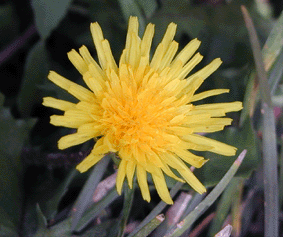Skip to content
Taraxacum spp.
 PLANT NAME: Taraxacum spp.
PLANT NAME: Taraxacum spp.
SYNONYMS OR SIMILARLY USED SPECIES: T. officinale, T. albidum, T. coreanum, T. laevigatum, T. japonicum, T. mongolicum, T. magellanicum, T. platycarpum, Leontodon latiloba, Leontodon taraxacum.
COMMON NAMES: Laulele, lauhele [Hawai’i]; pu gong ying [China]; dandelion [English]; butterblume, löwenzahn [Germany]; dent de lion, pissenlit [French]; dente de leone, soffione [Italy]; dente-de-leão [Portugese]; diente de león [Spanish]; doon-head clock [Scotland]; dughdapheni [Sanskrit]; hokoei [Japan]; mælkebøtte, løvetand [Denmark]; mniszek pospolity [Poland]; ogräsmaskrosor, maskros [Sweden]; paardebloem [Netherland]; ugrasløvetann, løvetann [Norway]; voikukka [Finland].
FAMILY: Asteraceae (dandelion family).
CATEGORY: Clear heat and toxins.
PROPERTIES: Bitter, cold.
PLANT PART USED: Whole plant. The root is the strongest part of the plant. Leaves are best for diuresis due to their potassium content.
PREPARATION OF MEDICINE: Decoction or tincture. Can also be used raw or juiced fresh.
STATUS IN HAWAI’I: Alien. Pest factor is surprisingly minimal.
WESTERN FUNCTIONS REPORTED: Aids digestion; alterative [China, New Zealand, Turkey]; analgesic [Bella Coola, Iroquois, Papago]; antibacterial (juice topical, decocted internal); antidiarrheal; anti-scorbutic; antiseptic for cystitis; aperient [France, USA]; astringent; bactericide; bitter tonic [Potawatomi (root)]; blood cleanser; blood medicine [Cherokee, Iroquois]; blood purifier; cathartic [Mohegan]; cholagogue [China, Mexico, Turkey]; clears the kidneys; depurative [Native American, Spain, Turkey]; dermatological aid; detoxicant [China]; diaphoretic [India, Japan]; diuretic [Europe, India, Nepal, Turkey, USA]; emetic [Iroquois (roots infused)]; eye medicine; febrifuge [Japan]; galactogogue [China]; gastrointestinal aid [Bella Coola]; gland stimulating; gynecological aid; heals wounds (juice topical); hemolytic; hepatic [India (root)]; hypoglycaemic; intoxicant; kidney aid; lactogogue [China, Japan]; laxative [Delaware, England, Iroquois, Mexico, Oklahoma, Turkey]; love medicine; orthopedic aid; physic [(leaves infused) Mohegan]; promotes metabolism; pulmonary aid; regulates the stomach; sedative [Cherokee]; stimulant (root) [India]; stimulates the bile ducts; stimulates the digestive glands; stimulates the pancreas; stomachic [China, Japan]; strengthens the liver; tonic [China, India, Japan, Mohegan, Nepal, Potawatomi, Shinnecock, USA, USSR]; toothache remedy; urinary aid; urinary disinfectant; witchcraft medicine.
RESEARCH:
-
Immune modulating in mice with burns [Luo 1993].
-
Constituents of Taraxacum spp. are immune potentiating and anticarcinogenic in mice [Jeong 1991; Takasaki (I) 1999; Takasaki (II) 1999]. However, effects on tumor necrosis factor and interleukin-1 are inconclusive [Kim 2000; Koo 2004]. Taraxinic acid, a constituent of Taraxacum coreanum, may inhibit human leukemia cells in vitro [Choi 2002].
-
Taraxacum mongolicum is antimicrobial against Bacillus dysenteriae, Corynebacterium diphtheriae, ECHO virus, Leptospira, Meningococci, Mycobacterium tuberculosis, Neisseria rneningitidis, Pneumococci, Pseudomonas aeruginosa, Shigella spp., Staphylococcus aureus, and Streptococcus pneumoniae [Bensky 1986] Taraxacum mongolicum is antiviral in vitro against type 1 Herpes simplex virus [Zhang 1990].
-
A constituent of Taraxacum platycarpum has anti-allergic properties [Cheong 1998].
TOXICITY: The LD50 in mice is 59g / kg. [Bensky 1986]
CAUTIONS AND CONTRAINDICATIONS:
-
There is a single human case report of anaphylaxis after ingesting the pollens of Taraxacum officinale (dandelion), Artemesia vulgaris (mugwort), and Salix alba (willow) [Chivato 1996].
-
Caution with gall bladder problems, gastric ulcer, weak digestion, liver problems.
NOTES ‘N QUOTES
-
Taraxacum officinale (the name for the common dandelion) is not actually a single species but an aggregate of many different species.
-
First recorded use was in China in the 7th century, in Arabian medical journals in the 10th century. In the West, the earliest reference found is by Hieronymus Bock in 1543. Taraxacum was established as a drug in Europe in the 16th Century.
-
Because of its’ high potassium content, dandelion replaces the potassium normally lost with herbs that promote urination.
-
This and Plantago spp. (laukahi) are two of the most versatile plant medicines we have. Laulele is a great secondary herb for a multitude of conditions. Like laukahi, it does many things reasonably well.

 PLANT NAME: Taraxacum spp.
PLANT NAME: Taraxacum spp.
